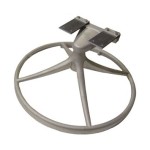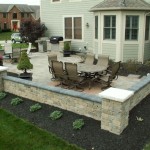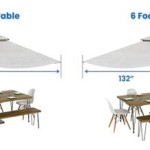How to Enhance the Aesthetic Appeal of Your Concrete Patio
A concrete patio, while durable and practical, can sometimes appear bland. Its utilitarian nature often overshadows its potential to be an attractive and inviting outdoor space. However, with a strategic approach, a concrete patio can be transformed into a visually appealing and enjoyable extension of the home.
Enhancing the aesthetic appeal of a concrete patio doesn't necessarily require extensive renovations or demolitions. Instead, it involves a combination of cleaning, repair, surface treatment, and strategic additions that complement the existing structure and elevate its overall appearance. The techniques used can range from simple DIY projects to more involved professional applications, depending on the desired outcome and budget. Understanding the various options available is crucial in making informed decisions that will yield the most significant impact on the patio's aesthetic.
Cleaning and Repair as Foundation
The initial step in improving the look of a concrete patio is thorough cleaning. Over time, concrete accumulates dirt, grime, mildew, and stains, which can significantly detract from its appearance. Pressure washing is an effective method for removing surface debris and embedded contaminants. However, care must be taken to avoid using excessive pressure, which can damage the concrete surface. A mild detergent or specialized concrete cleaner can be added to the pressure washer to enhance the cleaning process.
For stubborn stains, such as oil or rust, specialized cleaning agents may be required. These agents typically involve a chemical reaction that breaks down the stain, allowing it to be easily rinsed away. It's crucial to follow the manufacturer's instructions carefully when using any cleaning agent and to test it on an inconspicuous area first to ensure it doesn't discolor or damage the concrete.
In addition to cleaning, repairing any cracks or damage is essential. Cracks not only detract from the aesthetic appeal but can also lead to further deterioration of the concrete over time. Small cracks can be filled with a concrete patching compound, while larger cracks may require more extensive repair methods. Before applying any patching compound, the crack should be thoroughly cleaned and free of any loose debris. The patching compound should be applied according to the manufacturer's instructions, ensuring that it fills the entire crack and is level with the surrounding surface.
Spalling, which is the flaking or chipping of concrete surface, is another common issue. Small areas of spalling can be repaired with a concrete resurfacing product. Larger areas of spalling may require more extensive repair or even replacement of the affected section. Addressing these repairs proactively prevents further damage and creates a smooth, uniform surface for subsequent treatments.
Surface Treatments: Enhancing Color and Texture
Once the concrete is clean and repaired, various surface treatments can be applied to enhance its color and texture. These treatments can dramatically alter the appearance of the patio, transforming it from a plain gray slab into a visually appealing and inviting space.
Concrete staining is a popular option for adding color and depth to a concrete patio. Concrete stains penetrate the surface of the concrete, creating a permanent color that won't peel or fade. There are two main types of concrete stains: acid-based and water-based. Acid-based stains react chemically with the concrete, creating variegated and mottled effects. Water-based stains are more consistent in color and offer a wider range of color options. The choice between acid-based and water-based stain depends on the desired aesthetic and the existing condition of the concrete.
Concrete dyes are another option for adding color. Dyes are typically applied with a sprayer and penetrate the concrete surface. They are available in a wide range of colors and can be used to create custom designs and patterns. However, concrete dyes may be less durable than stains and may require a sealant to protect them from fading and wear.
Concrete overlays are a more substantial surface treatment that can completely transform the look of a patio. Overlays are a thin layer of concrete that is applied over the existing concrete surface. They can be textured, stamped, or colored to mimic the look of natural stone, brick, or tile. Overlays are a durable and versatile option for creating a custom look and can also be used to repair and hide existing imperfections in the concrete.
Stamped concrete is a technique that involves imprinting patterns into freshly poured concrete. It is often used to create the look of natural stone, brick, or tile. While stamped concrete is typically done during the initial concrete pour, it can also be achieved with concrete overlays. Stamped concrete adds texture and visual interest to the patio, making it a more appealing and inviting space.
Sealing the concrete after applying any surface treatment is crucial for protecting the finish and extending its lifespan. A concrete sealant protects the concrete from moisture, stains, and UV damage. Sealants are available in a variety of finishes, including matte, satin, and gloss. The choice of sealant depends on the desired look and the level of protection required.
Strategic Additions: Integrating Elements for Visual Harmony
Beyond surface treatments, strategic additions can further enhance the aesthetic appeal of a concrete patio. These additions involve integrating elements that complement the concrete and create a more inviting and functional outdoor space.
Outdoor furniture plays a significant role in the overall look and feel of a patio. Choosing furniture that complements the style and color of the concrete is essential. Consider the size and layout of the patio when selecting furniture to ensure that it doesn't overcrowd the space or impede traffic flow. Durable materials like teak, aluminum, and all-weather wicker are ideal for outdoor furniture as they can withstand the elements.
Adding potted plants and landscaping around the patio can soften the hardscape and create a more natural and inviting atmosphere. Plants can be arranged in various ways, from small potted succulents to large flowering shrubs. Consider incorporating plants that provide color, texture, and fragrance. Vertical planters can be used to add greenery to walls and fences, creating a lush and vibrant backdrop.
Outdoor lighting can transform a patio into a magical space after dark. String lights, lanterns, and spotlights can be used to create ambiance and highlight architectural features. Consider using solar-powered lights to save energy and reduce your carbon footprint. Path lighting can be used to illuminate walkways and steps, ensuring safety and visibility.
Adding an outdoor rug can inject color, pattern, and texture into the patio. Choose a rug that is specifically designed for outdoor use and that is resistant to moisture and fading. Outdoor rugs are available in a wide range of styles and materials, from natural fibers like jute and sisal to synthetic materials like polypropylene. A rug can help define a seating area or dining space and make the patio feel more cozy and inviting.
Incorporating a fire pit or outdoor fireplace can create a focal point and provide warmth and ambiance. Fire pits are available in a variety of styles and materials, from portable propane fire pits to permanent wood-burning fire pits. An outdoor fireplace can create a more sophisticated and elegant look. Consider the size of the patio and the local fire codes when choosing a fire pit or outdoor fireplace.
Adding decorative elements like sculptures, fountains, or wind chimes can personalize the patio and reflect your individual style. These elements can add visual interest and create a more inviting and relaxing atmosphere. Choose elements that complement the overall style of the patio and that are resistant to the elements.
Creating shade is important for making a patio comfortable during hot weather. A pergola, awning, or umbrella can provide shade and protection from the sun. A pergola can be covered with climbing plants to create a natural shade structure. A retractable awning can be adjusted to provide varying levels of shade. An umbrella is a portable and versatile option for providing shade.
Integrating these strategic additions in a cohesive manner will result in a visually harmonious and inviting concrete patio. The key lies in selecting elements that complement each other and the existing concrete structure, creating a seamless and enjoyable outdoor living space.

9 Great Concrete Patio Ideas For A Makeover Remodelaholic

3 Concrete Resurfacing Options For Patio

Resurfacing A Concrete Patio For Budget Diy Makeover Fab Everyday

Concrete Patio Ideas To Dress Up A Drab Space Bob Vila

Diy Concrete Patio Makeover The Frugal South

How To Create Faux Tile Look On Concrete Patio Southern Hospitality

How To Create Faux Tile Look On Concrete Patio Southern Hospitality

Inexpensive Ways To Cover A Concrete Patio

Backyard Makeover How To Paint Concrete Look Like Oversize Pavers A House Full Of Sunshine

Before And After Painted Concrete Patio Thistlewood Farm








